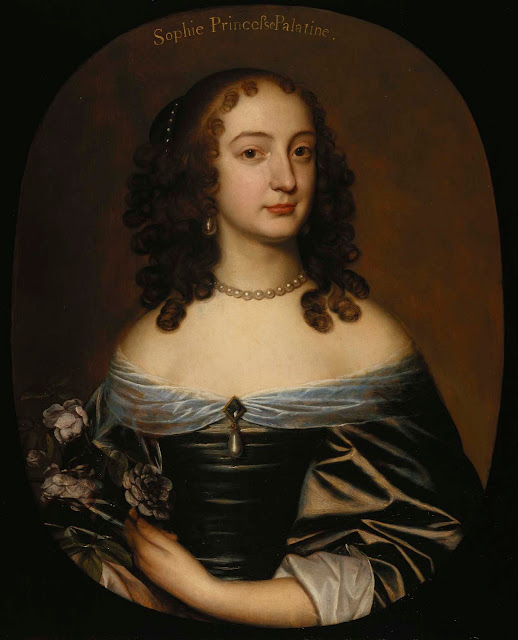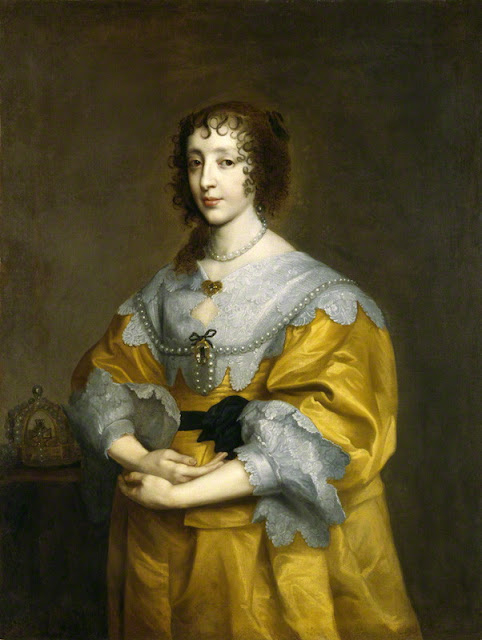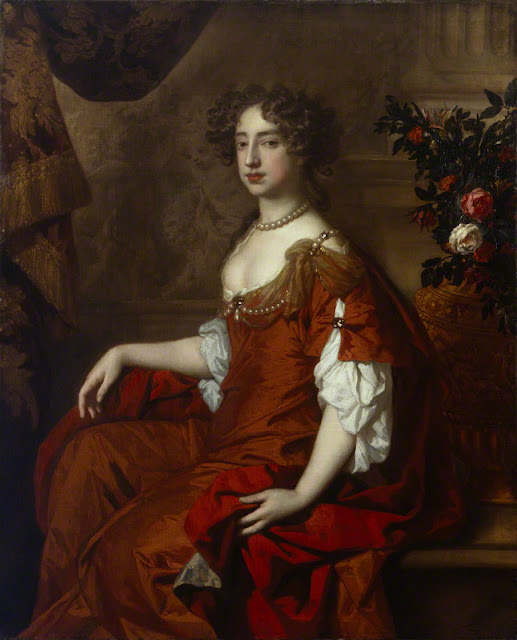 |
| Anonymous Elizabeth, Queen of Bohemia 1613 National Portrait Gallery (U.K.) |
 |
| Michael Janz. van Mierevelt Elizabeth, Queen of Bohemia 1623 National Portrait Gallery (U.K.) |
Curators at the National Portrait Gallery in London composed a fascinating paragraph about the pearsl in the 1623 portrait above of Elizabeth, daughter of King James I of England and sister of King Charles I. "In this portrait she may be shown wearing the famous Medici Pearls, also known as the Hanover Pearls, six strands joined together in a thick rope. The pearls have a long history. They were originally given to Catherine of Medici by Pope Clement VII; she in turn gave them to her niece, Mary, Queen of Scots. When Mary died the pearls were, it is thought, confiscated by Elizabeth I. On Elizabeth's death they passed to Mary's son James I who gave them to his daughter, Elizabeth of Bohemia. Elizabeth in turn gave them to her daughter Sophia on her marriage to the Elector of Hanover. The pearls returned to England with Sohpia's son George I, and remained here until the reign of Queen Victoria. Victoria refused to return the pearls to her uncle, the Duke of Cumberland, when he became the Elector. This led to a court case which lasted for twenty years and which was eventually settled in favour of Hanover. The pearls may never have been returned however. Queen Alexandra wore a choker of them and it is said that Elizabeth II has earrings and a diadem of the same provenance."
Pope Clement VII was Catherine de Medici's uncle and the architect of her entry into France. He bought the pearls in 1523, six ropes of them, plus two dozen larger and particularly comely individual pearls (such as those studding the coiffure of the Queen of Bohemia in the portrait at top). Two further portraits by Michael Janz. van Mierevelt (1567-1641) appear below, chosen for similar displays of pearls in heavy looping ropes.
 |
| Michael Janz. van Mierevelt George Villiers, 1st Duke of Buckingham ca. 1625 Art Gallery of South Australia |
 |
| Michael Janz. van Mierevelt Portrait of a woman ca. 1620 Prado |
Queen Elizabeth I was never short of pearls – with or without those of her kinswoman. The painting below is a colorful but in some ways unreliable image of Elizabeth in pearls. It was painted near the end of her life or shortly after her death, but then heavily repainted in the 18th century. I try to imagine the insane confidence of that late wielder of the brush who judged it best to obliterate the fabric wings supported on wire frames and the trailing veil that originally completed the Queen's costume in this portrait, as radiography reveals.
 |
| Anonymous Queen Elizabeth I early 17th century portrait repainted in the 18th century National Portrait Gallery (U.K.) |
 |
| Gerrit van Honthorst Elizabeth, Princess Palatinate 1640s National Portrait Gallery (U.K.) |
Elizabeth, Princess Palatinate (1618-1680) was "the eldest and most gifted" daughter of the Queen of Bohemia. She was not the daughter who inherited the famous pearls, although she may all the same be wearing some of them in the portrait above, since they were in the possession of her immediate family at the time the picture was made. This was the period of her friendship with Descartes, with whom she studied and whose patron she was. The Medici Pearls went to Sophia (1630-1714) the younger daughter (below) when she became Electress of Hanover.
 |
| Gerrit van Honthorst Sophia, Princess Palatinate 1648 Royal Collection (U.K.) |
Meanwhile, back in England, the Stuart court clung to the fetish for pearls. For most of the seventeenth century it was clearly all but inconceivable that an aristocratic portrait could be produced without a brave displays of pearls.
 |
| after Anthony van Dyck Queen Henrietta Maria ca. 1632-35 National Portrait Gallery (U.K.) |
 |
| Peter Lely Henrietta Anne, Duchess of Orleans (daughter of Charles I & Henrietta Maria) ca. 1662 National Portrait Gallery (U.K.) |
 |
| Peter Lely Princess Mary, later Queen Mary II 1677 National Portrait Gallery (U.K.) |
Although the curators spoke of Victoria's daughter-in-law Alexandra wearing a choker fabricated from some of the Medici Pearls, it could not be the one in the photograph below, because the individual pearls are obviously too small. In the next photograph, the short looped rope worn by the new queen at the old queen's funeral in 1901 are closer to the expected scale. One year later at her own coronation in 1902 Alexandra's distinguished bosom supported a profusion of pearls such as surely no previous monarch had ever attempted. Some of the Pope's pearls are surely hiding in there somewhere.
 |
| George Lafayette Alexandra, Princess of Wales 1897 National Portrait Gallery (U.K.) |
 |
| W. & D. Downey Queen Alexandra at Queen Victoria's funeral 1901 carte-de-visite National Portrait Gallery (U.K.) |
 |
| Anonymous Queen Alexandra at her Coronation 1902 National Portrait Gallery (U.K.) |
The final photograph shows Mary of Teck, the new Princess of Wales wearing mourning for Queen Victoria. Rather than the pearls, though (which we have seen before), the most striking aspect of the future Queen Mary's photograph is the startling resemblance of her youthful facial features to those of her granddaughter, the present Queen.
 |
| Anonymous Mary, Princess of Wales 1901 National Portrait Gallery (U.K.) |